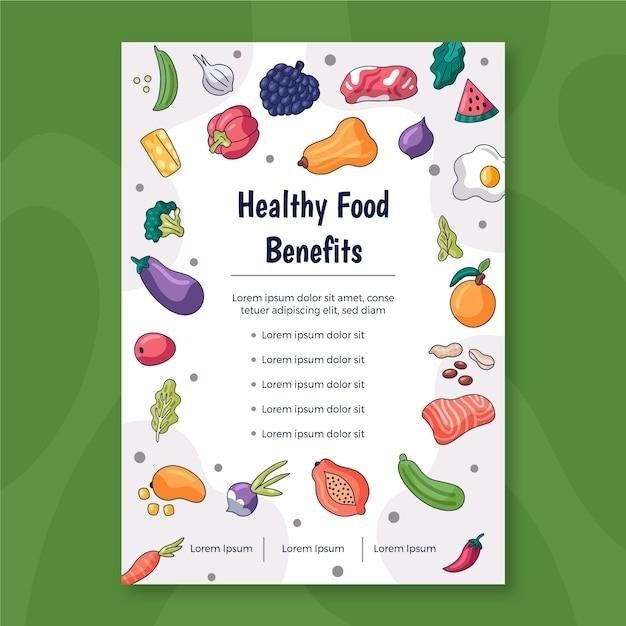
low-fat diet food list pdf
What is a Low-Fat Diet?
A low-fat diet restricts the amount of fat consumed. It’s often recommended for weight loss, managing digestive issues, or certain health conditions. Food labels indicating “fat-free,” “low-fat,” or similar terms help identify suitable options. Remember, individual needs vary.
Defining Low-Fat
The term “low-fat” on food labels isn’t universally standardized, leading to potential confusion. The FDA defines “low-fat” as containing 3 grams or less of fat per serving. However, this doesn’t automatically signify healthiness; consider the overall nutritional profile. “Fat-free” or “zero fat” indicates less than 0.5 grams of fat per serving, a stricter criterion. Understanding these distinctions is crucial for informed food choices. Always examine the total fat content in relation to serving size and other nutritional components (such as saturated and trans fats, cholesterol, and sodium). Don’t solely rely on the “low-fat” label; prioritize whole, unprocessed foods whenever possible. Remember that even low-fat options can be high in sugar or other undesirable additives. A balanced approach is key; focus on a variety of nutrient-rich foods rather than strictly adhering to one label.
Benefits of a Low-Fat Diet
Reducing dietary fat can contribute significantly to overall health and well-being. A low-fat approach is often associated with weight management, as high-fat foods tend to be calorie-dense. By limiting fat intake, individuals may find it easier to create a calorie deficit, leading to weight loss or maintenance. Furthermore, studies suggest a link between lower fat consumption and a reduced risk of cardiovascular diseases, such as heart disease and stroke. This is partly because saturated and trans fats, often found in processed foods and animal products, can elevate cholesterol levels, increasing the risk of heart problems. A low-fat diet, emphasizing lean proteins, fruits, vegetables, and whole grains, may also help regulate blood sugar levels, potentially benefiting individuals with diabetes or those at risk of developing the condition. However, it’s crucial to remember that a balanced approach is essential; completely eliminating fats can deprive the body of essential fatty acids vital for various bodily functions. Consult a healthcare professional or registered dietitian to determine if a low-fat diet is appropriate for your specific health needs.
Low-Fat Diet Food List
This section details foods suitable for a low-fat diet, categorized for easy meal planning. We’ll explore fruits, vegetables, lean protein sources, and dairy alternatives. Remember to always check food labels.
Fruits and Vegetables
Most fruits and vegetables are naturally low in fat, making them excellent additions to a low-fat diet. Embrace a wide variety of colorful options for optimal nutrient intake. Berries (strawberries, blueberries, raspberries) are low in calories and packed with antioxidants. Citrus fruits (oranges, grapefruits, lemons) are rich in Vitamin C and fiber. Melons (watermelon, cantaloupe, honeydew) provide hydration and essential vitamins. Apples, pears, and bananas offer fiber and natural sweetness. Leafy greens (spinach, kale, lettuce) are nutrient powerhouses. Cruciferous vegetables (broccoli, cauliflower, Brussels sprouts) are rich in vitamins and fiber. Root vegetables (carrots, sweet potatoes, beets) offer diverse nutrients and flavors. Consider incorporating peppers, onions, mushrooms, and zucchini for added variety and texture. Remember that avocados and coconuts are exceptions, being higher in fat content.
Protein Sources
Lean protein sources are crucial for a balanced low-fat diet. Prioritize poultry (chicken breast, turkey breast) without the skin, as skin significantly increases fat content. Fish (salmon, tuna, cod) offer omega-3 fatty acids alongside protein, but be mindful of portion sizes and preparation methods. Lean cuts of beef and pork (loin, sirloin) can be included in moderation, trimming away visible fat before cooking. Beans (kidney, black, pinto) and lentils are excellent plant-based protein sources, providing fiber and other nutrients. Eggs (especially egg whites) are a versatile and affordable protein choice. Tofu and tempeh, made from soybeans, offer plant-based protein and are relatively low in fat. Consider incorporating nuts and seeds (almonds, walnuts, chia seeds, flaxseeds) in moderation, as they are higher in healthy fats but still provide protein and other nutrients. Remember to check nutrition labels to ensure you’re selecting lean protein options and managing portion sizes.
Dairy Alternatives
For individuals following a low-fat diet or those with lactose intolerance, dairy alternatives offer a variety of options. Soy milk, almond milk, and oat milk are popular choices, often available in unsweetened varieties to minimize added sugars. Check nutrition labels carefully, as some brands may contain added oils or sugars that increase the fat content. Unsweetened almond milk, for example, is a naturally low-fat option, while some soy milk varieties might be higher in fat depending on the brand and processing methods. Rice milk is another alternative, though it tends to be lower in protein compared to soy or almond milk. Coconut milk, while creamy, is higher in fat and should be used sparingly. Consider the nutritional profile of each alternative, paying attention to protein, calcium, and vitamin content to ensure you’re meeting your daily requirements. Many fortified plant-based milks provide added calcium and vitamin D, important for bone health. Explore different brands to find flavors and consistencies you enjoy while maintaining a low-fat intake.

Creating a Low-Fat Meal Plan
Planning low-fat meals involves selecting lean protein sources, ample fruits and vegetables, and whole grains. Sample meal plans and grocery lists can simplify the process, ensuring balanced nutrition while limiting fat intake.
Sample Meal Plans
Several sample meal plans are available online and in various resources to guide you in creating a low-fat diet. These plans typically outline breakfast, lunch, and dinner options for a week or even a month, emphasizing low-fat choices while ensuring nutritional balance. A 7-day plan might include oatmeal with berries for breakfast, a large salad with grilled chicken or fish for lunch, and baked salmon with steamed vegetables for dinner. A 4-week Mediterranean-style plan might offer a variety of options including whole grains, lean proteins, and plenty of fruits and vegetables. These plans often include recipes and shopping lists, making it easier to stick to the low-fat diet. Remember to consult your doctor or a registered dietitian before starting any new diet plan, especially if you have underlying health conditions. They can help you tailor a plan that meets your individual needs and health goals. You can find these sample plans in PDF format online, often accompanied by additional helpful information and resources, making meal planning for a low-fat diet more manageable and accessible.
Grocery List Essentials
Creating a comprehensive grocery list is crucial for successful low-fat eating. Prioritize purchasing fresh produce, including a wide variety of fruits and vegetables low in fat and rich in nutrients. Select lean protein sources such as skinless poultry, fish, and beans. Opt for low-fat or fat-free dairy alternatives like skim milk and nonfat yogurt. Whole grains like brown rice and oats are excellent choices for complex carbohydrates; When choosing condiments, select low-fat options to minimize added fat and calories. Remember to check food labels diligently to ensure that you are selecting products that meet your low-fat dietary goals. Consider purchasing healthy fats sparingly, such as avocados and nuts, to maintain a balanced diet. Planning your meals ahead of time can significantly simplify your grocery shopping experience. By creating a detailed grocery list based on your chosen meal plan, you can avoid impulsive purchases of high-fat items and ensure your pantry and refrigerator are stocked with low-fat essentials.
Tips for Reducing Fat Intake
Carefully read food labels, focusing on total fat, saturated fat, and trans fat content per serving. Choose cooking methods that minimize added fats, such as baking, grilling, or steaming.
Reading Food Labels
Understanding food labels is crucial for successful low-fat dieting. Pay close attention to the “Nutrition Facts” panel, specifically focusing on the “Total Fat,” “Saturated Fat,” and “Trans Fat” grams per serving. These values provide a clear picture of the fat content within a single serving of the product. Remember that serving sizes can vary significantly between brands and even within a brand’s product line, so always check this information carefully. “Low-fat” claims are regulated, meaning a product labeled as “low-fat” must meet specific criteria regarding the amount of fat it contains per serving. However, even low-fat options can contain added sugars or unhealthy additives. Therefore, reviewing the entire ingredient list is equally important to ensure you’re selecting products that align with your dietary goals. Don’t hesitate to compare different brands or product variations to find the best fit for your needs and preferences. By consistently reading food labels and paying attention to the details, you can make more informed decisions that support your commitment to a low-fat lifestyle.
Cooking Methods
Choosing the right cooking methods is essential for maintaining a low-fat diet. Frying foods in oil significantly increases their fat content, so it’s best avoided or minimized. Instead, opt for healthier alternatives such as baking, grilling, steaming, or broiling. These methods require little to no added oil, preserving the natural flavors of your ingredients while keeping the fat content low. When using oil, choose healthier options like olive oil or avocado oil in moderation. These oils contain monounsaturated and polyunsaturated fats, which are considered healthier than saturated and trans fats commonly found in other cooking oils. Remember that even seemingly healthy cooking methods can add extra fat if you’re not careful. For instance, excessive use of butter or margarine during baking can negate the benefits of other healthy cooking choices. Experiment with different herbs, spices, and citrus juices to add flavor without relying on added fats. This approach will help you create delicious and satisfying low-fat meals that support your overall health goals. Always check labels on prepared sauces and condiments as they may contain hidden fats.

Maintaining a Low-Fat Lifestyle
Sustaining a low-fat lifestyle requires a holistic approach that goes beyond just dietary changes. It involves conscious choices in various aspects of life. Regular physical activity plays a crucial role in weight management and overall health, complementing the benefits of a low-fat diet. Aim for at least 150 minutes of moderate-intensity aerobic exercise per week, combined with strength training exercises twice a week. Mindful grocery shopping is paramount. Plan your meals in advance, create detailed shopping lists, and stick to them to avoid impulse purchases of high-fat items. Focus on whole, unprocessed foods, and limit processed foods, sugary drinks, and excessive amounts of saturated and trans fats. Develop healthy cooking habits by embracing low-fat cooking methods like baking, grilling, and steaming, and use healthier oils sparingly. Reading food labels diligently helps you make informed decisions and choose products that align with your dietary goals. Seek support from healthcare professionals such as registered dietitians or nutritionists for personalized guidance and meal planning. Remember, consistency and gradual lifestyle changes are key to long-term success in maintaining a healthy low-fat lifestyle. Don’t be afraid to seek support from family and friends as you navigate this journey towards a healthier you.